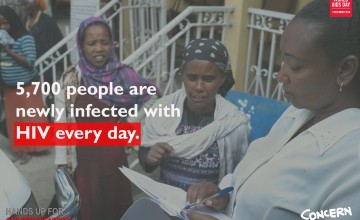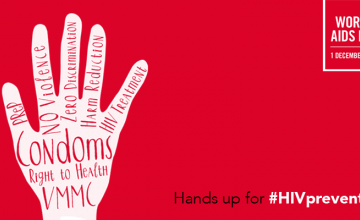
Read our 2024 annual report

Knowledge Hub
AIDS complacency can kill
On World AIDS Day Breda Gahan – Concern’s Global Health and HIV Team Lead – reflects on the risks of complacency and the importance of ensuring that no-one is left behind in terms of HIV and AIDS prevention and treatment.
Since the early 1980’s, 78 million people have become infected with HIV and 35 million have died from AIDS related illnesses up to the end of 2015. All people living with HIV in the early days died. The lead singer of Queen, Freddie Mercury, died of AIDS 25 years ago last month, in November 1991. There is still no cure for AIDS.
In the mid-1990s, anti-retroviral treatment (ART) began extending the lives of people living with HIV in countries in Europe, and in the USA and Australia. It took almost a decade later before ART began reaching people in significant numbers in the world’s poorest countries in Africa and in Asia.
We are now into the fourth decade of AIDS, and marking the 28th anniversary of World AIDS Day which was launched by the World Health Organisation on 1 December 1988.

Latest statistics and good news on treatment scale up
At the end of 2015, 36.7 million people were living with HIV, with more women than men infected in the world. About 5,700 people are newly infected with HIV every day. The majority of people living with HIV reside in low- and middle-income countries, particularly in Sub-Saharan Africa. Ongoing drivers of HIV and AIDS include poverty, inequality, the injustice of low access to HIV testing and ART treatment, and pervasive stigma and discrimination. In some countries, HIV transmission is a criminal offence, affecting especially key populations including migrants, refugees, prisoners, people who inject drugs, men who have sex with men, and sex workers.
The good news is that more and more people are now accessing ART, with 18.2 million people currently receiving this life-saving medication, including 910,000 children. The glass is nearly half-full. Irish Aid and other donors are funding the response. Since 2007 Irish Aid is the main contributor to Irish NGOs’ global HIV and AIDS response, funding nearly 70% of their projects fully or partially.
The extreme poor are being left behind
Of great concern to me are the 18.5 million people who are still unable to access HIV treatment, particularly the extreme poor and stigmatised key populations.
Concern Worldwide calls on UNAIDS to include the ‘extreme poor’ – those being left behind – among the 12 populations at higher risk of HIV infection. They are an extremely vulnerable population, who can lose their lives and livelihoods when they cannot access quality, sustained ART, and adequate nutritious food.
Over 18 million people infected with HIV and not receiving treatment, and a further 180 million people are negatively impacted in households where HIV is present. The household situation often spirals these families further into poverty, as they can spend what little money they have on medication that does not work.
Hands Up for #HIV Prevention
The world, including UNAIDS has now realised that we can’t treat ourselves out of the HIV and AIDS epidemic, and this year’s World AIDS Day theme is ‘Hands Up for #HIV Prevention’. Prevention is always best, and HIV is technically almost 100% preventable.

Concern’s response
Concern is supporting HIV risk and vulnerability reduction with implementing partners in all our education, health, livelihood and multi-sector programmes. We achieve this through effective mainstreaming and integration of responses in all countries, and in all contexts. All main donors support these efforts, and there is high awareness and increasing knowledge on HIV among our target populations, especially in sub-Saharan Africa.
Through our urban poverty programme in Bangladesh, we aimed to reduce risk and vulnerability by providing pavement, squat and slum dwellers with orientation on HIV transmission and safer behaviours to lower their risk.
Mainstreaming of cross-cutting issues, including HIV responses, is part of our Wolayita integrated development programme in Ethiopia, with awareness raising training on gender, HIV and AIDS and accountability facilitated with target populations.
In Burundi, knowledge, attitudes and practices regarding HIV and AIDS, family planning and hygiene has increased in the project areas. In Niger, substantial efforts have been made to reach target communities using mass communication campaigns and through training community health workers for outreach.
HIV and AIDS remains a very sensitive issue in Sudan. Our programme there aims to reduce HIV and AIDS related stigma. In collaboration with the Sudan National AIDS Programme (SNAP), the health and nutrition sector organised a two day HIV and AIDS anti-stigma campaign with influential local leaders during 2015.
Concern Malawi in partnership with Grassroot Soccer uses the power of sport to educate, inspire, and mobilize adolescents through fun and interactive HIV prevention and life skills curricula, aiming for safer behaviour practices and health positive social change.

Concern teams with partners in Kenya, Uganda and Zambia support prevention of mother-to-child transmission of HIV through strengthening health service delivery.
Last year, restrictions on public gatherings in Sierra Leone and Liberia due to the ebola epidemic thwarted efforts to engage in community sensitisation on HIV and AIDS and offer voluntary and confidential counselling and testing (VCCT) there. However, these were also resumed at the end of 2015.
The danger of increasing complacency
There is increasing complacency regarding the danger of HIV and AIDS among younger populations. Today, only 36% of young men and 30% of young women (ages 15-24) in sub-Saharan Africa have comprehensive and correct knowledge of how to prevent HIV infection. Young people nowadays are often unaware that so many people died of HIV and AIDS related illnesses in the 1980s and 1990s.
To date this year in Ireland, 463 people have been newly diagnosed with HIV (HPSC). Social behaviour change interventions are necessary in this country also.
There is increasing complacency among some international donors, organisations and national governments who think that current ART coverage is greater than it is and that “AIDS is over”.
Positively, some African countries are sensitive to the latest data and are now contributing to their in-country HIV and AIDS response, but a significant resource gap exists. The Global Fund for AIDS, TB and Malaria is underfunded.
Recent updated UNAIDS estimates indicate that US$ 26.2 billion will be required for the AIDS response in 2020, with US$ 23.9 billion required in 2030.
The concern of HIV and AIDS resurgence was discussed at the Durban HIV and AIDS Conference in which I participated in July 2016. A study, published in The Lancet HIV last July, reported HIV infection rates increasing in 74 countries.
“The findings reveal challenges that the global health community faces in the effort to end AIDS by 2030, among other global goals,” says Haidong Wang, the lead author on the study and an associate professor at the Seattle-based Institute for Health Metrics and Evaluation (IHME).
Leadership, stewardship, financing, human resources and essential quality HIV services including testing and treatment are fundamental to stopping HIV rising again.
Complacency can kill
Old Act Up posters with their “Silence = Death” / “Ignorance = Fear” messages perturbed many people in the past.
Today AIDS complacency can kill. AIDS is still not over, especially for poorest people living with and affected by HIV and AIDS in poorest countries.
Let’s not be silent.
Let’s not be complacent.
Lives and livelihoods of people living with HIV who are not currently on ART matter, as do the lives of their affected families, households, neighbours and friends.


